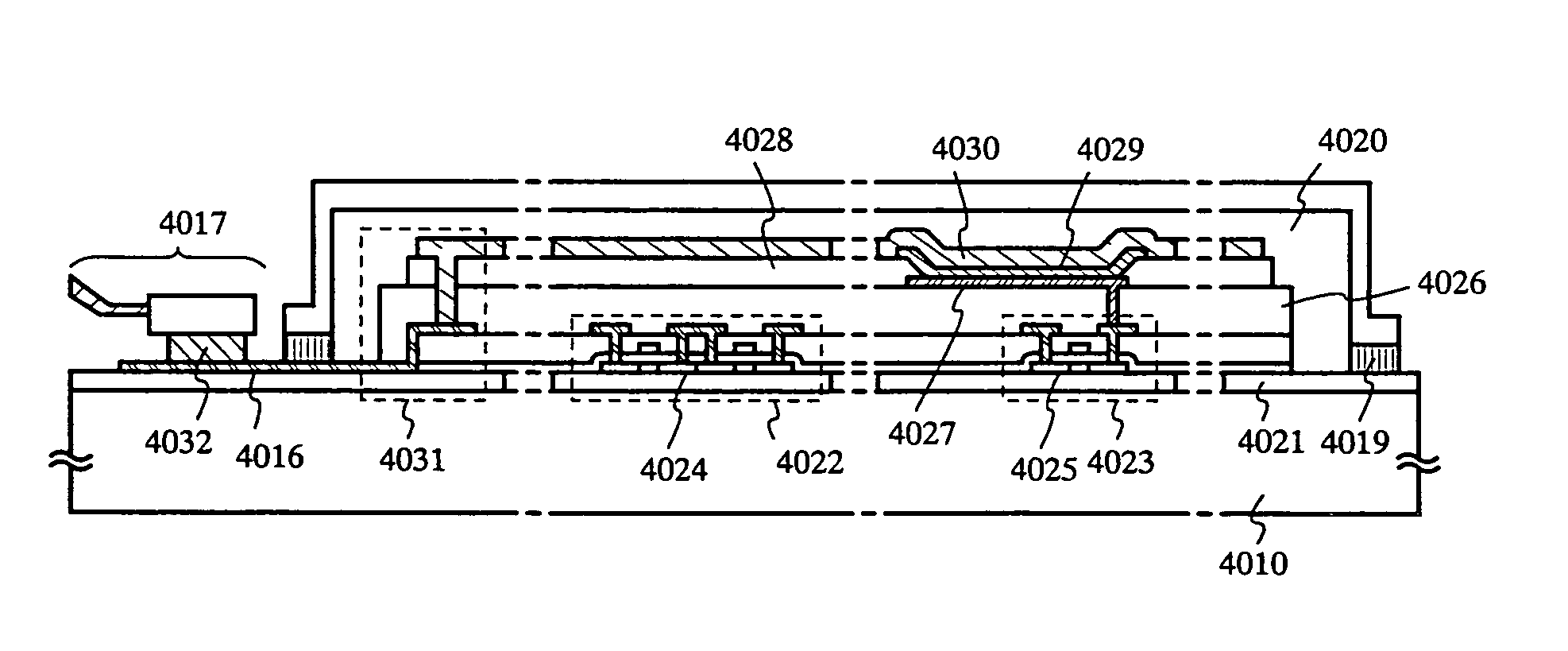Semiconductor device having El layer and sealing material
a technology of sealing material and semiconductor film, which is applied in the direction of discharge tube luminescnet screen, discharge tube/lamp details, electric discharge lamps, etc., can solve the problems of powder explosion, slow speed of reduced pressure cvd film formation, and process that uses plasma cvd has a disadvantage from a workplace safety perspective, so as to promote crystallization and reduce the concentration of catalytic elements
- Summary
- Abstract
- Description
- Claims
- Application Information
AI Technical Summary
Benefits of technology
Problems solved by technology
Method used
Image
Examples
embodiment 1
[0087]In this embodiment, a description will be made on an example in which a CMOS circuit, that is a part of a peripheral drive circuit, and a pixel TFT, that is a part of a pixel matrix circuit, are formed on the single same substrate using the present invention. The semiconductor device and its manufacturing method will be described briefly with reference to the simple cross sectional drawings shown in FIGS. 1 to 6B.
[0088]First the substrate 100 is prepared. In this embodiment, a glass substrate (Corning 1737, distortion point 667° C.) is used. Next, after a base insulating film (hereinafter in this specification, referred to as base film) is formed on top of the substrate 100, it is annealed. The heat treatment here is performed below the distortion point of the substrate, preferably between 200 and 700° C. In Embodiment 1, TEOS and oxygen (O2) are used as raw material gasses in a plasma CVD apparatus in order to form a 200 nm thick silicon oxide film as the base film 101, which...
embodiment 2
[0111]This embodiment takes an example in which a process that differs from that of Embodiment 1 is used to obtain a crystalline semiconductor film. In Embodiment 2 an additional process is performed before or after formation of the semiconductor film of Embodiment 1, which places a catalytic element either selectively or over the entire semiconductor surface, in order to promote crystallization. The basic structure of Embodiment 2 is similar to that of Embodiment 1, therefore the focus of the description will be on the differences only.
[0112]Embodiment 2 is the same as Embodiment 1 through the process of forming the semiconductor film by sputtering.
[0113]A catalytic element to promote silicon crystallization is introduced into the semiconductor film surface in Embodiment 2. Elements Ni, Fe, Co, Pt, Cu, Au, and Ge may be used either singly, or in combination, as the catalyst for promoting silicon crystallization. Ni was chosen for Embodiment 2 due to its quick diffusion speed throug...
embodiment 3
[0118]This embodiment takes an example in which a process that differs from that of Embodiment 1 is used to obtain a crystalline semiconductor film. In Embodiment 1, after the heat treatment is given on the base film, a semiconductor film is formed by sputtering, but in Embodiment 3, the base film and the semiconductor film are formed in succession, without exposure to the atmosphere.
[0119]First, a plastic substrate is prepared. A silicon nitride film is formed on top of the substrate by sputtering to act as a base film, and an amorphous silicon film is laminated, also by sputtering, to act as a semiconductor film. The two films are formed in succession, without exposure to the atmosphere. It is possible to create a clean interface between the base film and the semiconductor film with this processing method.
[0120]Next, laser light irradiation is used to form a crystalline semiconductor film by crystallizing the amorphous silicon semiconductor film. Further, a gate insulating film ma...
PUM
 Login to View More
Login to View More Abstract
Description
Claims
Application Information
 Login to View More
Login to View More - R&D
- Intellectual Property
- Life Sciences
- Materials
- Tech Scout
- Unparalleled Data Quality
- Higher Quality Content
- 60% Fewer Hallucinations
Browse by: Latest US Patents, China's latest patents, Technical Efficacy Thesaurus, Application Domain, Technology Topic, Popular Technical Reports.
© 2025 PatSnap. All rights reserved.Legal|Privacy policy|Modern Slavery Act Transparency Statement|Sitemap|About US| Contact US: help@patsnap.com



